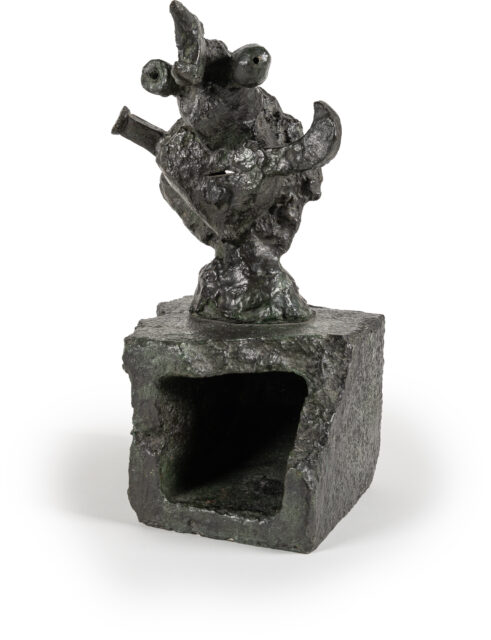Tête
Details
Jouffroy/Teixidor 179; Miró/Ortega Chapel 207. Provenance: Pierre Matisse Gallery, New York;Galerie Lelong, Paris; private collection, Monaco.
Descrizione
• Characteristically humorous, surrealist work by Joan Miró
• Based on the assemblage and “objet trouvé” techniques
• Only eight examples of this bronze were cast Joan Miró was one of the most important representatives of abstract surrealism with an unmistakable and unique world of forms and motifs.
He is primarily known for his extensive painted and printed oeuvre, but he was also active in the field of sculpture. Regardless of the artistic medium in which Miró chose to express himself, his work is always characterised by a playful grace and sense of lightness. Joan Miró created his first surrealist sculptures as early as 1930. They were designed as assemblages or images made from “objet trouvé” – found materials. From the 1960s onwards, he began creating large-scale, often colourfully painted sculptures for public spaces as well as smaller works cast in bronze in the assemblage style. The model for the sculpture “Tête” from 1970 was also obviously assembled from various found objects before it was cast in bronze. You can still see a bottle cap as the right hand, a metal hook as the left arm and a ball or a short piece of pipe as the eyes. “Miró did not create his sculptures as a way to relax from painting. For him, the real adventure only began with sculpture. In the possibility of expression offered by the medium – and the way in which he approached the work – he found direct contact with reality, which he could otherwise only access through his complicated visual language when painting. (…) It all starts with an improvised harvest. Miró would disappear silently from his studio and return loaded like a peddler with things that no longer held any value and were no longer needed, but that, in his opinion, could still evoke unfamiliar associations and undergo unexpected metamorphoses. (…) there are no unimportant things, there are only missed opportunities. Miró’s first concern was not aesthetic. He was not concerned with the beauty of the forms or their uniqueness. Rather, the sculptor was gripped by the energy, the charisma of each object, by the potential power that lay within it, which he had first to capture and then slow down in order for it to be emphasised through the way the other objects combined with this one. (…) (It is striking that Miró turns to objects) that are so commonplace that we no longer even notice them: bent nails, rusted iron parts, a piece of board, broken bricks, shards of a jug, bottle corks, old pot lids, pieces of wood (…). Sometimes the moment comes when the whole thing flares up mystically, when the game that was only intended for fun turns into The Great Game – the amusement becomes a subversive act. This all happens on the basis of improvisation or chance. There are no rules for the beginning of the game, but the reward awaits at the end.” (Jacques Dupin, Miró als Bildhauer, in: exhibition cat. Joan Miró. Skulpturen, Kunsthalle der Hypo-Kulturstiftung, Munich 1990, p. 19f.).
* Tutte le informazioni includono la commissione a carico dell'acquirente (27%) senza IVA e senza garanzia. Salvo errori.
** Tutte le informazioni più la commissione a carico dell'acquirente e l'IVA e senza garanzia. Salvo errori.
*** Con riserva: L'offerta è stata accettata al di sotto del limite. L'acquisizione dell'opera potrebbe essere ancora possibile nella nostra vendita post-asta.
R = Le opere d'arte regolarmente tassate
N = Opere d'arte soggette a tassazione differenziata e provenienti da un paese non UE
Non è consentita la riproduzione e la distribuzione privata o commerciale di tutte le illustrazioni delle opere esposte nell'archivio della mostra e dell'asta. Tutti i diritti riservati.


